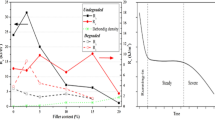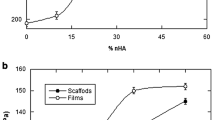Abstract
The objective of this study was to investigate the thermal expansivities and degradation properties for several in vitro conditioned biodegradable poly(lactic acid)/hydroxyapatite (PLA/HA) and poly(lactic acid)/β-tricalcium phosphate (PLA/βTCP) composites with different mass% of the particle reinforcements (i.e. 10, 20 and 30). The samples were prepared by extrusion followed by injection moulding and incubated in a customized simulated body fluid at 37 °C over 60, 90, 120, 150 and 180 days, respectively. Thermal expansion and degradation properties of in vitro conditioned samples, along with dynamic mechanical properties of unconditioned ones, were systematically investigated through coefficients of linear thermal expansion and thermal strain changes, decomposition temperatures, mass changes and per cent residues. The results indicated that PLA/βTCP composites performed better than PLA/HA composites, irrespective of their filler mass%, revealing high values of glass transition temperatures, around a mean value of 65 °C, both on dynamic mechanical analysis and on dilatation measurements but lower values on their degradation temperatures, such as 360 °C. The results suggest the feasibility of tailoring high-loaded osteoconductive fillers-reinforced PLA composites for various medical and engineering applications.










Similar content being viewed by others
References
Auras R, Lim LT, Selke S, Tsuji H. Poly(lactic acid): structures, production, synthesis, and applications. New York: Wiley; 2010.
Murariu M, Dubois P. PLA composites: from production to properties. Adv Drug Deliv Rev. 2016;107:17–46.
Haaparanta A-M, Haimi S, Ellä V, Hopper N, Miettinen S, Suuronen R, et al. Porous polylactide/β-tricalcium phosphate composite scaffolds for tissue engineering applications. J Tissue Eng Regen Med. 2010;4(5):366–73.
Ahmed J, Varshney SK. Polylactides—chemistry, properties and green packaging technology: a review. Int J Food Prop. 2011;14(1):37–58.
Garlotta D. A literature review of poly(lactic acid). J Polym Environ. 2001;9(2):63–84.
Slomkowski S, Penczek S, Duda A. Polylactides—an overview. Polym Adv Technol. 2014;25(5):436–47.
Avinc O, Khoddami A. Overview of poly(lactic acid) (PLA) fibre. Fibre Chem. 2009;41(6):391–401.
Akindoyo JO, Beg MDH, Ghazali S, Heim HP, Feldmann M. Impact modified PLA-hydroxyapatite composites—thermo-mechanical properties. Compos A Appl Sci Manuf. 2018;107:326–33.
Nazhat SN, Kellomäki M, Törmälä P, Tanner KE, Bonfield W. Dynamic mechanical characterization of biodegradable composites of hydroxyapatite and polylactides. J Biomed Mater Res. 2001;58(4):335–43.
Ignjatovic N, Uskokovic D. Synthesis and application of hydroxyapatite/polylactide composite biomaterial. Appl Surf Sci. 2004;238(1):314–9.
Li J, Zheng W, Li L, Zheng Y, Lou X. Thermal degradation kinetics of g-HA/PLA composite. Thermochim Acta. 2009;493(1):90–5.
Zhang SM, Liu J, Zhou W, Cheng L, Guo XD. Interfacial fabrication and property of hydroxyapatite/polylactide resorbable bone fixation composites. Curr Appl Phys. 2005;5(5):516–8.
Akindoyo JO, Beg MDH, Ghazali S, Heim HP, Feldmann M. Effects of surface modification on dispersion, mechanical, thermal and dynamic mechanical properties of injection molded PLA-hydroxyapatite composites. Compos A Appl Sci Manuf. 2017;103:96–105.
Kang Y, Yao Y, Yin G, Huang Z, Liao X, Xu X, et al. A study on the in vitro degradation properties of poly(l-lactic acid)/β-tricalcuim phosphate(PLLA/β-TCP) scaffold under dynamic loading. Med Eng Phys. 2009;31(5):589–94.
Huang J, Ten E, Liu G, Finzen M, Yu W, Lee JS, et al. Biocomposites of pHEMA with HA/β-TCP (60/40) for bone tissue engineering: swelling, hydrolytic degradation, and in vitro behavior. Polymer. 2013;54(3):1197–207.
Bleach NC, Nazhat SN, Tanner KE, Kellomäki M, Törmälä P. Effect of filler content on mechanical and dynamic mechanical properties of particulate biphasic calcium phosphate—polylactide composites. Biomaterials. 2002;23(7):1579–85.
Ferri J, Gisbert I, García-Sanoguera D, Reig M, Balart R. The effect of beta-tricalcium phosphate on mechanical and thermal performances of poly(lactic acid). J Compos Mater. 2016;50(30):4189–98.
Li X, Qi C, Han L, Chu C, Bai J, Guo C, et al. Influence of dynamic compressive loading on the in vitro degradation behavior of pure PLA and Mg/PLA composite. Acta Biomater. 2017;64:269–78.
Agrawal CM, McKinney JS, Lanctot D, Athanasiou KA. Effects of fluid flow on the in vitro degradation kinetics of biodegradable scaffolds for tissue engineering. Biomaterials. 2000;21(23):2443–52.
Kikuchi M, Koyama Y, Takakuda K, Miyairi H, Shirahama N, Tanaka J. In vitro change in mechanical strength of β-tricalcium phosphate/copolymerized poly-L-lactide composites and their application for guided bone regeneration. J Biomed Mater Res. 2002;62(2):265–72.
Lim LT, Auras R, Rubino M. Processing technologies for poly(lactic acid). Prog Polym Sci. 2008;33(8):820–52.
Ignjatovic N, Suljovrujic E, Budinski-Simendic J, Krakovsky I, Uskokovic D. Evaluation of hot-pressed hydroxyapatite/poly-L-lactide composite biomaterial characteristics. J Biomed Mater Res B Appl Biomater. 2004;71B(2):284–94.
Martin C. Twin screw extrusion for pharmaceutical processes. In: Repka MA, Langley N, DiNunzio J, editors. Melt extrusion: materials, technology and drug product design. New York: Springer; 2013. p. 47–79.
Cox SC, Thornby JA, Gibbons GJ, Williams MA, Mallick KK. 3D printing of porous hydroxyapatite scaffolds intended for use in bone tissue engineering applications. Mater Sci Eng C. 2015;47:237–47.
Corcione C, Scalera F, Gervaso F, Montagna F, Sannino A, Maffezzoli A. One-step solvent-free process for the fabrication of high loaded PLA/HA composite filament for 3D printing. J Therm Anal Calorim. 2018;134:1–8.
Siqueira L, Passador FR, Costa MM, Lobo AO, Sousa E. Influence of the addition of β-TCP on the morphology, thermal properties and cell viability of poly (lactic acid) fibers obtained by electrospinning. Mater Sci Eng C. 2015;52:135–43.
Drummer D, Cifuentes-Cuéllar S, Rietzel D. Suitability of PLA/TCP for fused deposition modeling. Rapid Prototyp J. 2012;18(6):500–7.
Ferri J, Jordá J, Montanes N, Fenollar O, Balart R. Manufacturing and characterization of poly(lactic acid) composites with hydroxyapatite. J Thermoplast Compos Mater. 2018;31(7):865–81.
Ferri J, Jordá J, Montanes N, Fenollar O, Balart R. Manufacturing and characterization of poly(lactic acid) composites with hydroxyapatite. J Thermoplast Compos Mater. 2018;31(7):865–81.
Menczel JD, Prime RB. Thermal analysis of polymers: fundamentals and applications. New York: Wiley; 2014.
Aboudi J, Arnold SM, Bednarcyk BA. Chapter 3—fundamentals of the mechanics of multiphase materials. In: Aboudi J, Arnold SM, Bednarcyk BA, editors. Micromechanics of composite materials. Oxford: Butterworth-Heinemann; 2013. p. 87–145.
Esposito Corcione C, Gervaso F, Scalera F, Padmanabhan SK, Madaghiele M, Montagna F, et al. Highly loaded hydroxyapatite microsphere/PLA porous scaffolds obtained by fused deposition modelling. Ceram Int. 2018;45:2803–10.
Zou H, Yi C, Wang L, Liu H, Xu W. Thermal degradation of poly(lactic acid) measured by thermogravimetry coupled to Fourier transform infrared spectroscopy. J Therm Anal Calorim. 2009;97(3):929.
Schindler A, Doedt M, Gezgin Ş, Menzel J, Schmölzer S. Identification of polymers by means of DSC, TG, STA and computer-assisted database search. J Therm Anal Calorim. 2017;129(2):833–42.
Lee WA, Knight GJ. Ratio of the glass transition temperature to the melting point in polymers. Br Polym J. 1970;2(1):73–80.
Author information
Authors and Affiliations
Corresponding author
Additional information
Publisher's Note
Springer Nature remains neutral with regard to jurisdictional claims in published maps and institutional affiliations.
Rights and permissions
About this article
Cite this article
Ferri, J.M., Motoc, D.L., Bou, S.F. et al. Thermal expansivity and degradation properties of PLA/HA and PLA/βTCP in vitro conditioned composites. J Therm Anal Calorim 138, 2691–2702 (2019). https://doi.org/10.1007/s10973-019-08799-0
Received:
Accepted:
Published:
Issue Date:
DOI: https://doi.org/10.1007/s10973-019-08799-0




